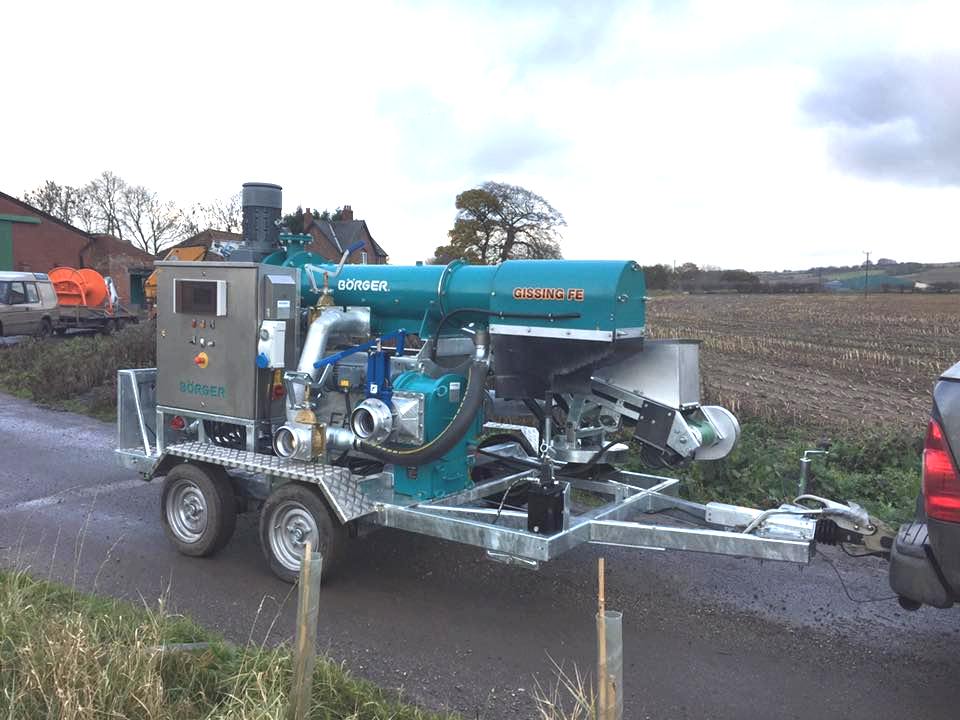We are pleased to be able to report that highly significant savings have been achieved in agricultural slurry pumping costs at a farm-based AD Plant in Lincolnshire, as reported by Borger Pumps in combination with the distributor of their agricultural products Gissing FE.
Watch our video below, or read the written article which follows. We think that you will agree that this seems to be exactly what has been done by a clever combination of skills. It's a combination of pump specialist Borger's skills, and the practical application of know-how by Gissing FE, made possible by an in-depth appreciation of what the farmer needs.
This has reportedly made great savings by getting advanced pump technology work on the ground for the farmer. In fact, they do seem to have worked a bit of magic, with this trailer-mounted product!
What is Agricultural Slurry Pumping?
In the agricultural industry, slurry pumping is used to move animal waste from one place to another. The animal waste is often mixed with water and other materials. Slurry pumps are used in both dairy farming and pig farming.
The use of slurry pumps has been on the rise in recent years as more farmers have started using them for their livestock operations. The benefits of using a slurry pump are many, including less risk of contamination, lower risk of odor and odors, reduced manure runoff into waterways, and decreased labour costs.
Outside agriculture the slurry pump is used for the transport of liquid material, such as sewage and other types of watery sludge.
All Slurry Pumps Suck (But Not in a Bad Way!)
A common feature of the slurry pump is that it is a device that uses the power of suction to move liquid from one place to another. It has a long suction tube that is inserted into the body of liquid, which creates a vacuum and pulls the liquid up into the tube.
The slurry pump is an important component of the Borger Bioselect Separator, a machine that separates the liquid from the solids in animal waste. Slurry pumps are also used on farms to pump manure and other liquids out of tanks and pits.
The trailer-mounted pump system and Bioselect Slurry Separator (also known as a Digestate Separator ) can be moved easily to where it is needed. It solved the case study farm businesses' previous problems with high maintenance and the need to run multiple centrifugal pumps to achieve the necessary high pressures. Not only that, the result has been both a low-maintenance and a low-running-cost solution.
Press Release:
Big Agricultural Slurry Pumping Savings Achieved at Farm-Based AD Plant
A Borger macerator and two pumps from Borger are helping provide significant agricultural slurry pumping and handling savings at a farm-based AD plant in Lincolnshire.

Part of a custom-built trailer system designed and built by Gissing FE, exclusive distributors of Borger’s equipment for the UK agricultural market, the macerator handles digestate from the farm’s lagoon, whilst the new rotary lobe pumps have replaced inefficient centrifugal units.
Requiring just one generator to power three electric motors, Gissing’s space-saving (20’ by 15’, including pipework) container system reduces emissions for a spreading operation that would usually need two to three large tractors, plus the diesel and manpower to go with it.
“Previously,” said Jason Gissing, the farmer had to have three centrifugal pumps in line, which with three lots of fuel, was very inefficient. The impellers on this design of pump will only spin so fast without being able to handle the digestate from the AD plant – and they were also heavy on wearing parts and very time-consuming to service.”
“However, with the self-priming Borger pumps”, he added, “they hold their pressure much longer to supply a higher volume of slurry – and with their Maintenance-In-Place design, are much, much easier to service – half the time or less than the centrifugal pumps”.
To further benefit the farm’s AD plant, Gissing has also designed its bespoke container system so that it can be utilised for spreading as well as stirring the lagoon. The Borger pumps can be started, stopped, revved up and down – all from the operator’s cab – from where the driver can also see what flow rates are being achieved, and if necessary, divert.
Gissing’s experience in the UK agricultural market goes back to 1938. The company is fourth-generation, family-owned and run. Truly a team of expert specialists.
Borger is owned and run by its founder Alois Börger (who began the company almost 40 years ago), together with his family.
In addition to its pumps and macerators, Borger also supplies its BioSelect Separator for the AD/agricultural market.
The Separator has throughputs up to 150m3/h and can be very easily integrated into an existing system or used as a mobile separator (trailer-based).
Börger UK Limited – 01902 798977 – uk@boerger.com
Advances in Agricultural Slurry Pumping Just One Example of UK Anaerobic Digestion Industry Innovation
While the UK anaerobic digestion industry is lacking in government support, as we have reported previously in this blog, and although badly in need of decisions on funding such as the Renewable Heat Incentive (RHI), it can still innovate.
This Press Release once again shows that there is still enormous potential for the anaerobic digestion industry to reduce its biogas production costs, and as it reduces its overheads and passes a proportion of that on to its energy customers, its cost competitiveness with traditional fossil fuel-based fuels will improve.
All that is needed is some short-term funding from the UK government to provide the industry with enough confidence to continue investing in technology advances of the sort we see in this press release, and the future of AD will expand greatly.
There are admittedly some current problems with the availability of some organic feedstock materials, however, there are also many untapped organic feedstock sources which will come available as the cost of anaerobic digestion falls and further innovation, and thus efficiency improvements take place.
There has also been an explosion in academic research on AD in the last 5 years, new AD processes have been shown to be viable and many variations on existing practices have been researched and shown to have potential. Very little of that work has yet flowed into the AD industry and given time, it will do so.
But, very often it is the basic solutions once achieved in what may look like an obvious and simple progression after they have been done, that can have as big an impact as any number of academic reports.
It is very possible that what we have seen here in Gissing's trailer-mounted Borger equipment is an example of that. An example of the sort of practical advances which bring the biggest results.
In this case study, we think that enabling the system to be run off a generator and used almost anywhere on the farm brings the practicality of the Borger equipment up to a new level of usefulness. We think that what we have seen confirms the value of the agricultural slurry pumping savings reported at a farm-based AD plant, as reported by Borger working with Gissing FE.
[Article first published August 2017. Updated September 2022.]





Definitely believe that that you stated reduced slurry pump costs. Your reason seems to be at the internet the simplest factor to consider of. I say to you, I definitely get annoyed while folks say slurry costs are unsurmountable. You managed to hit the nail upon the point. Will likely be again to get more. Thanks
I couldn’t refrain from commenting. We have said much the same on our website. Perfectly written!
Agricultural slurry pumping demands the use of the right equipment. Only buy from the long-established pumping equipment supplier, the company I work for has been certified to several industrial certificates. It is essential to take every link of the quality control systems serious, assuring that each pumping unit will enjoy good quality and reliable performance.
In Poland agricultural biogas plants are part of the Plan for Responsible Development inspired by Deputy Prime Minister Mateusz Morawiecki, because they stabilize local energy production, usually have domestic owners, interact with the agri-food sector and give new jobs, often in Eastern Poland. According to the amended Act on Renewable Energy Sources, in the future they may be a link of an inter-municipal energy cluster.
Biogas is the most ideal solution for rural energy from farm waste. Rural homes require cooking fuel and electricity and they are in need of a reliable electricity option that has a local source of supply. Moreover, considerable quantities of raw material are available in the rural areas for biogas production. This is ALL good. Keep on doing this blog, for all to use.
Thanks for finally writing about Agricultural Slurry Pumping Savings at Farm Based AD Plants. 3 cheers for Anaerobic Digestion Community Website. Loved it!